Getting to know each member of your target audience individually is infeasible. This is why you need to create a buyer persona. It helps to create a picture of your ideal customer based on the common aspects shared among your potential customers.
Buyer personas play a major role in helping you create the right message and deliver it to the right people.
If you still haven’t created a buyer persona of your audience or are in the process of building one, let this easy guide help you out. You can make use of the buyer persona templates below to get a headstart.
- What is a Buyer Persona
- The Role of Buyer Personas in Marketing and Understanding Target Audiences
- How to Create a Buyer Persona
- Buyer Persona Templates
- Why You Need to Continuously Update and Refine Your Buyer Persona
- Common Mistakes to Avoid when Creating a Buyer Persona
What is a Buyer Persona?
A buyer persona, also known as a customer persona, audience persona or marketing persona, is a document that describes who your ideal or target customer is. And it helps you create personalized messages to your customers using the right tone and voice.
It is based on extensive research on your target audience, educated guesses and even on interviews with the customers themselves.
The buyer persona consists of information like who they are, what they do, their goals and interests, their behavior and so on. Basically, you can include any aspect of the audience that you think would help you market better to your target audience.
They may differ from company to company, and information relevant to one business may not make sense to the other.
And there could be several key segments in your audience. While they might not share the same characteristics, you can create several buyer personas to represent each of these segments.
Buyer Persona vs User Persona
While the buyer persona profiles the people who are in the process of making the decision to buy your product or service, user personas capture information about people who are already directly using your products or services.
The Role of Buyer Personas in Marketing and Understanding Target Audiences
Buyer personas are essential tools for understanding and connecting with your target audience. By incorporating them into your marketing strategy, you can build stronger customer relationships, increase conversions, and drive business growth.
Targeted marketing: Buyer personas help you understand your ideal customers inside out. You get to know what they want, what motivates them, and what keeps them up at night. Armed with this knowledge, you can create marketing that speaks directly to their needs, making it more personal and relevant.
Enhanced customer understanding: Buyer personas go beyond basic demographics and give you insights into their behaviors, thoughts, and decision-making processes. This deep understanding helps you truly connect with your customers and develop products, services, and marketing campaigns that truly address their pain points.
Improved communication: Buyer personas provide insights into how your target audience prefers to communicate and engage with brands. This knowledge allows you to select the best channels to reach them, the right tone to use, and the messaging style they resonate with. This means better engagement, stronger connections, and more effective communication.
Precise content creation: With buyer personas, you can create content that speaks directly to your audience’s interests and challenges. Whether it’s a blog post, a social media update, or an email campaign, you can ensure that it resonates with the right audience and drives higher engagement and conversion rates.
Product development and innovation: Buyer personas guide product development by helping you identify the features, functionalities, and solutions that align with your target audience’s needs and preferences. By incorporating their feedback and pain points into your product development process, you can create offerings that truly meet customer expectations and stand out in the market.
Effective customer acquisition and retention: Buyer personas enable you to identify the most promising segments of your target audience and focus your resources on acquiring and retaining customers with the highest potential for long-term value. By tailoring your marketing strategies and customer experience to specific buyer personas, you can attract and retain customers more effectively, leading to improved customer satisfaction and loyalty.
Data-driven decision making: They provide a framework for making smart decisions based on real insights. By analyzing data related to specific personas, you’ll gain valuable insights into their behaviors and preferences, allowing you to fine-tune your strategies and make better-informed choices.
How to Create a Buyer Persona
Now that you know what a buyer persona is, let’s see how you can create one on your own.
Step 1: Conducting research
Conducting research on your audience is an important part of creating a buyer persona. Research provides you with factual data. On the other hand, making guesses or assumptions about your target customers will only mislead you.
There are many ways you can gather information on your customers. And the areas you should focus on when collecting data are:
- Demographics
- Education
- Career and working life
- Daily life
- Consumer habits
- Paint points, goals, challenges
- Finances
- Personality and personal life
- Online behavior
- Product preferences
Existing customers:
If you already have customers, it’s better to start from them. Ask your sales team or the marketing team to learn what they know as they already interact with your existing customers.
Or you can communicate with them directly over the phone, via email, etc. You can also send them questionnaires.
Got social media followers? There are many valuable insights you can gain from looking into their profiles as well.
Competitor’s Customers:
If you are starting new and have no leads, you can start with the customers of your competitors. Track them down on review sites, and on social media.
Target Market:
You can rely on social media and website analytics to find unique information (i.e. the keywords they used) about people who are interacting with you online, even if they are not your customers yet.
Here are some more user research methods to gather data to create a buyer persona.
- Interviews: Conduct one-on-one interviews to gather insights into user behaviors and preferences.
- Surveys: Use questionnaires to collect data on demographics, preferences, and patterns.
- Observational studies: Observe users in their natural environment to understand their needs.
- Data analysis: Analyze quantitative data, like website analytics, for user behavior patterns.
- User testing: Observe users performing tasks related to your product or service.
- Customer support Analysis: Review support tickets and feedback to identify common issues.
- Online research: Explore online communities and forums to gain user insights.
- Persona workshops: Organize collaborative workshops to define user characteristics.
- Secondary research: Review existing market research and industry reports.
- Empathy mapping: Create visual representations of user thoughts, feelings, and needs.
By combining these methods, you’ll gain valuable insights to develop accurate and effective buyer personas.
Step 2: Narrowing down the details
Look for details that are common in the answers given by the users or the research data you have found. For example, most people in your target audience may face the same kind of issue at their office. This could be an important detail that should be included in the buyer persona.
Narrow down the basic information you need for the persona, such as demographics, interests and challenges, behaviors, etc.
To create a detailed and relatable representation of the target audience, focus on these common components of a buyer persona.
- Demographic Information: Age, gender, location, education, occupation, income.
- Background and Goals: Personal and professional history, aspirations.
- Pain Points and Challenges: Obstacles and concerns they face.
- Motivations and Values: Core drivers and beliefs.
- Buying Behavior: Decision-making process and influences.
- Communication Style: Preferred channels and engagement methods.
- Influences and Information Sources: Key influencers and trusted sources.
- Customer Journey: Stages from awareness to conversion and beyond.
- Quotes and Anecdotes: Direct quotes or stories to humanize the persona.
Step 3: Segmenting customers
Not all customers can fit into the same group. Your audience may include customers aged 60 as well as aged 15. And their preferences may be wildly different. And the same sales approach may not work for both generations.
As you filter through the information you have gathered from your research, you will be able to come across different segments in your target audience based on their preferences, goals, habits, etc.
You can create different buyer personas for each of them.
Step 4: Creating your buyer persona
Now that you have gathered all the information you want on your ideal customer(s), it’s time to create your buyer persona.
Going this extra mile to neatly organize the data you have gathered will come in handy in many use cases. It will be easy for anyone to refer to and comprehend at a glance, and you can share it with multiple departments by keeping it in a central location or embedding it in an internal wiki, website, etc.
Here are a few best practices you can adhere to when creating a solid buyer persona
- Give each of your buyer personas a name (i.e. Mark or Mary)
- Add a profile picture to personalize it even more
- Categorize data for easy comprehension (i.e. demographics, interests, goals, etc.)
- Include excerpts from interviews with your customers or survey answers
Get started with this simple buyer persona template;
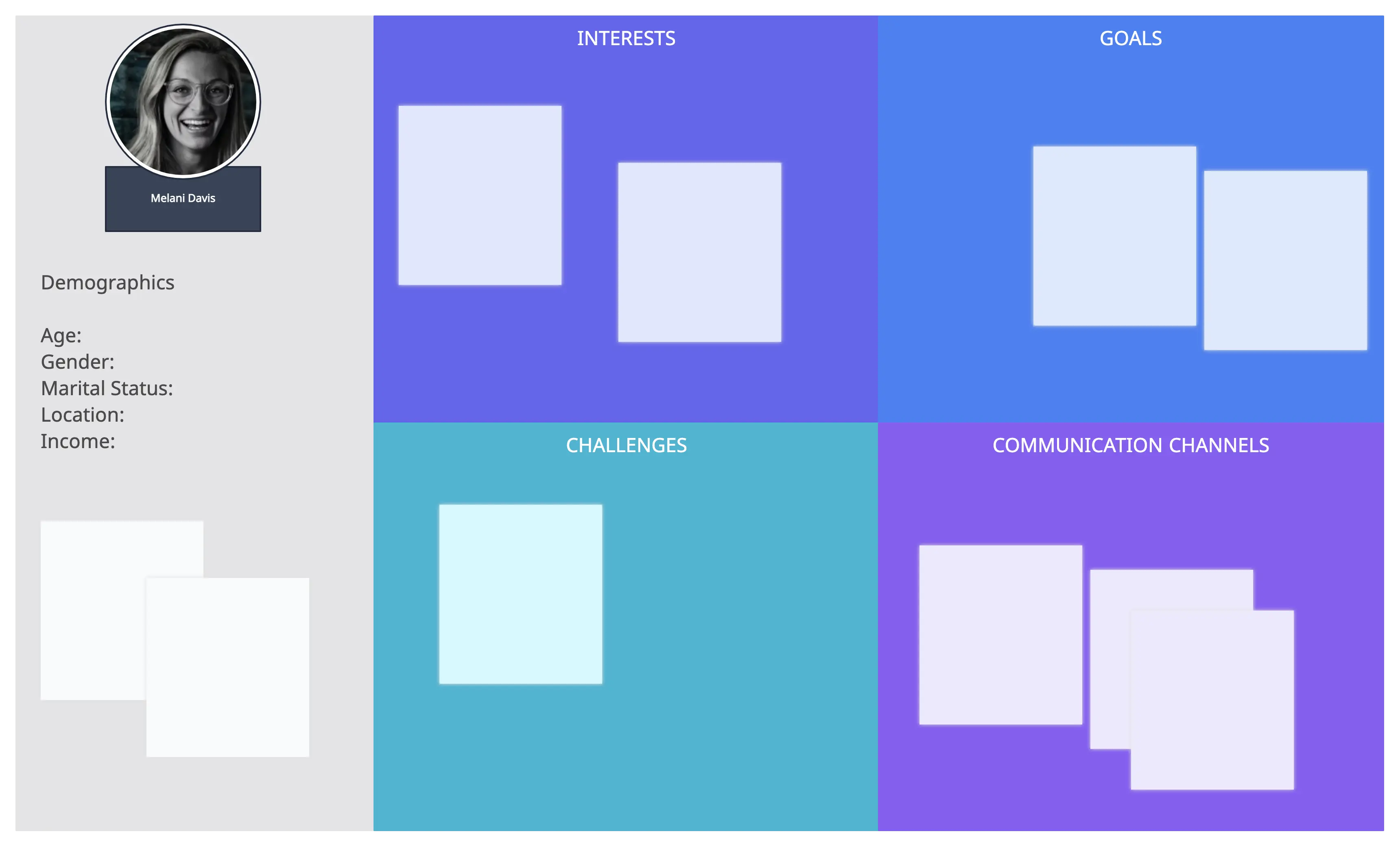
Buyer Persona Templates
These templates are editable. Invite others in your team to help complete them in real-time as well. You can also download them as SVGs, PNGs, or JPEGs for publishing.
B2B Buyer Persona Template
A B2B buyer persona represents the buyers who make purchasing decisions on behalf of the companies they work for. They don’t make impulsive buying decisions and depend on educational and credible content to make decisions. It’s important to focus on building credibility and trust with them before purchase.
In a B2B buyer persona, you should be focusing more on their job details which you can easily find through their LinkedIn profiles. You should also look into the people who are directly reporting to them.
Plus knowledge about the organization itself, like the products and services they offer, number of employees, hierarchy, etc. will be useful when you are making a B2B buyer persona.

B2C Buyer Persona
A B2C buyer persona represents an individual who will be buying your product or service with their own money. While you should include details about their professional lives in a B2C buyer persona, you don’t have to go into much detail like you should in a B2B buyer persona.
Instead, you can focus more on their personal life, their online behavior and what influences their buying decisions.
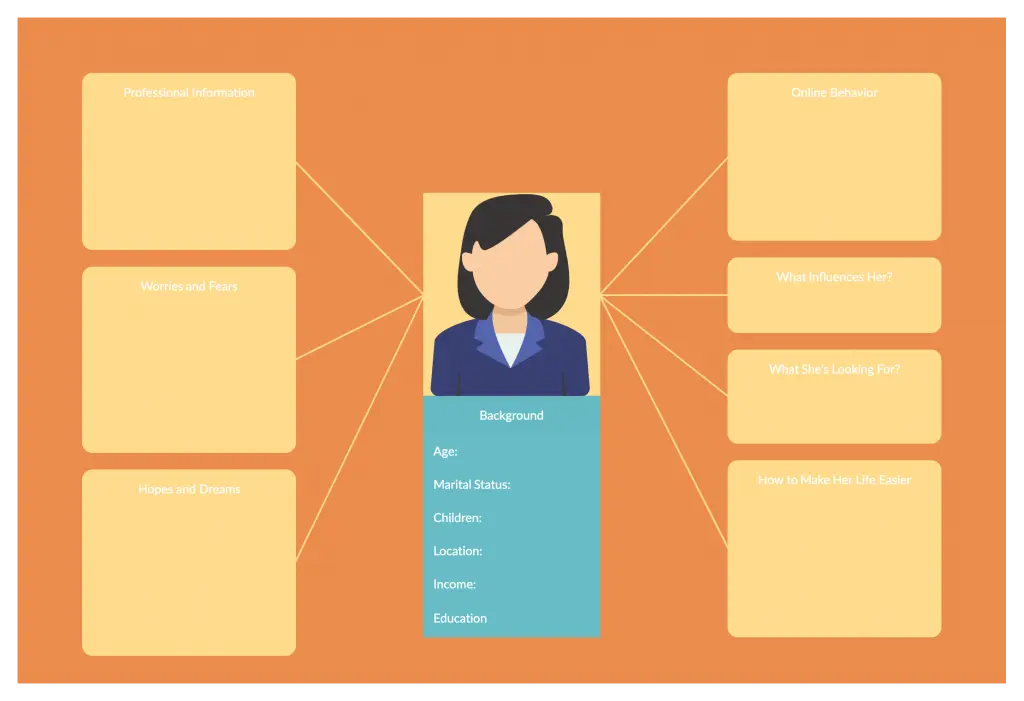
Buyer Persona Canvas
The buyer persona canvas, similar to the business model canvas, is a strategic modeling tool designed by Tony Zambito. It is used to help the development of a buyer persona. The canvas highlights 10 areas that you need to focus on in order to deeply understand your buyer.
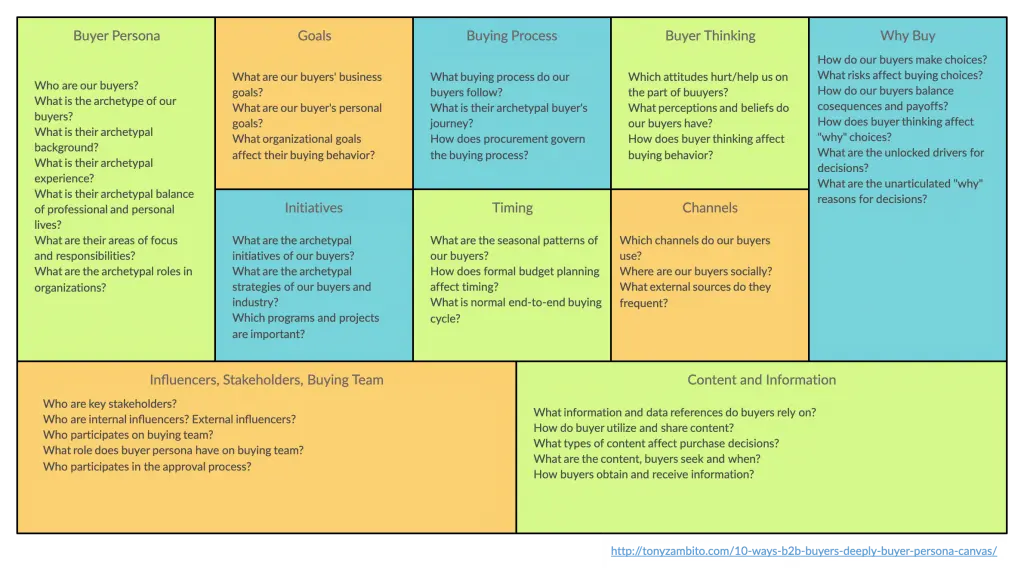
Customer Profile Template 1

Audience Profile Template 2

Customer Profile Template 2
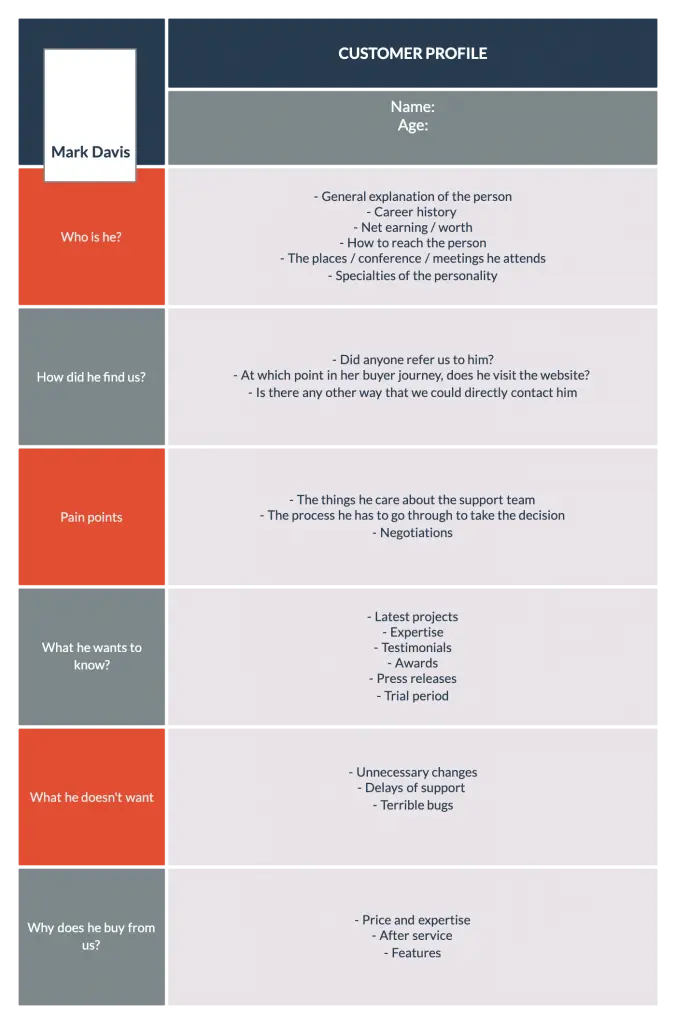
Customer Profile Template 3
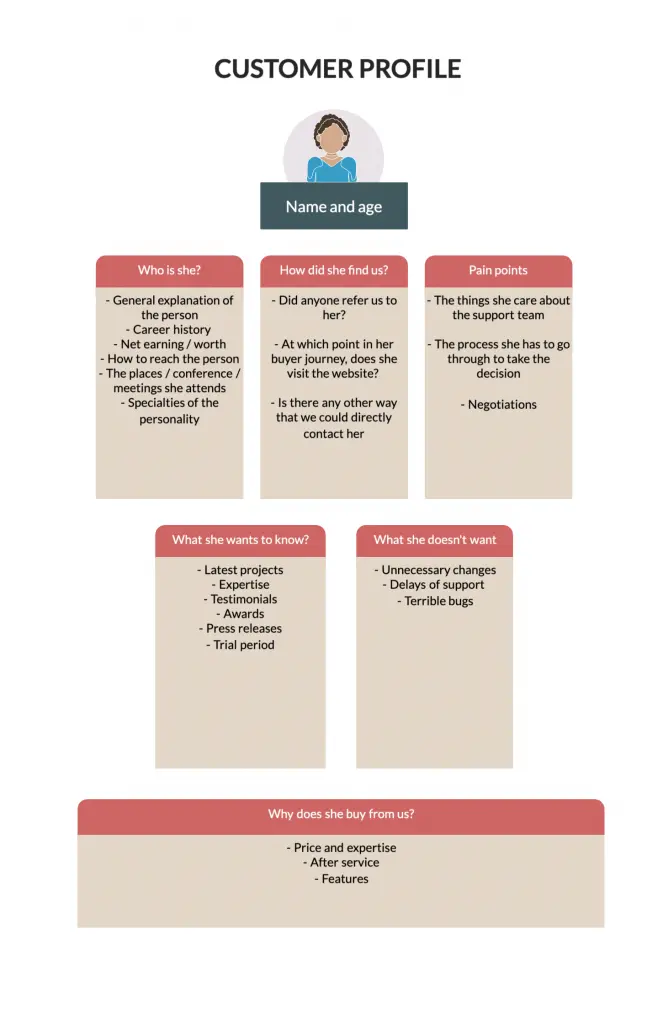
Why You Need to Continuously Update and Refine Your Buyer Persona
By continuously updating and refining your personas based on new insights and feedback, you can maintain a deep understanding of your target audience, make informed decisions, and deliver a more personalized and relevant experience that drives business success.
- Evolving target audience: Customer preferences, behaviors, and market dynamics change over time. By updating personas, you stay aligned with the evolving needs and expectations of your target audience.
- Accurate decision-making: Updated personas provide accurate and up-to-date information for decision-making. As you gather new insights, you can make informed strategic choices, such as refining marketing strategies or developing new products/services.
- Improved messaging and personalization: It enable you to fine-tune your messaging and content to better resonate with your audience. By understanding their evolving pain points, motivations, and preferences, you can tailor your communication to be more relevant and personalized.
- Enhanced customer experience: It helps you stay in tune with your customers' changing expectations and deliver an improved customer experience. By understanding their evolving needs, you can develop products, services, and touchpoints that meet their expectations effectively.
- Better targeting and acquisition: Persona refinements enable more precise targeting and customer acquisition strategies. You can identify new segments or subgroups within your audience and tailor your marketing efforts accordingly to attract and convert them.
- Alignment across teams: Updated personas ensure consistent understanding and alignment across different teams within your organization. Marketing, sales, product development, and customer service teams can all benefit from the most up-to-date information on your target audience.
Common Mistakes to Avoid when Creating a Buyer Persona
Avoid these common mistakes to create more accurate, insightful, and effective buyer personas that truly represent your target audience, leading to more successful marketing campaigns and better customer engagement.
Making assumptions: Relying on assumptions or generalizations about your target audience can lead to inaccurate personas. Base your personas on real data and insights gathered through research and feedback.
Overgeneralizing: Avoid creating overly broad personas that try to encompass everyone. Instead, focus on specific segments or subgroups within your target audience to create more targeted and effective personas.
Neglecting research: Skipping or inadequately conducting research is a common mistake. Thoroughly research your target audience through surveys, interviews, data analysis, and market research to ensure your personas are based on accurate and reliable information.
Lack of validation: Failure to validate your personas can result in misleading assumptions. Seek feedback and input from customers, sales teams, and other stakeholders to validate and refine your personas.
Lack of detail: Creating shallow or incomplete personas can limit their usefulness. Include sufficient details about demographics, behaviors, motivations, goals, challenges, and preferences to create comprehensive personas that truly represent your target audience.
Ignoring negative characteristics: It’s important to include the challenges, objections, and negative characteristics of your target audience in your personas. Understanding these aspects can help you address them effectively in your marketing strategies.
Static personas: Treating personas as fixed and unchanging can lead to outdated and irrelevant profiles. Continuously update and refine your personas as you gather new insights and as your target audience evolves over time.
Disregarding multiple personas: If your business caters to different customer segments, it’s crucial to create multiple personas. Neglecting to differentiate between these segments can result in generic messaging that fails to resonate with any specific group.
Lack of alignment with strategy: Ensure that your personas align with your overall business strategy and goals. Your personas should directly inform and guide your marketing, product development, and customer experience strategies.
What are Your Thoughts on Using a Buyer Persona?
Not only to shape marketing or sales strategies, but buyer personas can also be used to create new products that your customers would love. Buyer personas can evolve as you get to know more about your customer, so remember to update it along the way.
Got any tips on using a buyer persona? Do share with us in the comments section below.
FAQs on Buyer Personas
A buyer persona is important for several reasons:
- Buyer personas help companies understand the needs, motivations, and behavior patterns of their target audience, allowing them to create more targeted and effective marketing campaigns.
- By creating a comprehensive representation of the target customer, companies can gain a deeper understanding of their needs and preferences, which can inform product development and customer experience design.
- Buyer personas help companies create more relevant content, product offerings, and experiences that resonate with their target audience.
- By creating a customer-centric marketing strategy that speaks directly to the needs of the target audience, companies can increase conversion rates and generate more leads and sales.
- Buyer personas can help companies segment their target audience into different groups, allowing them to create more targeted marketing strategies for each segment.
- By creating a shared understanding of the target audience, buyer personas help align all stakeholders, including marketing, product development, and customer service, towards a common goal of delivering a better customer experience.
A negative buyer persona is a representation of a target customer who is unlikely to purchase a product or use a service. This type of persona is used to understand and exclude people who are unlikely to engage with the company, thus helping to optimize the marketing and sales efforts. Negative buyer personas are typically created based on data and insights gathered from previous customer interactions.
By understanding the characteristics of negative buyer personas, companies can optimize their marketing and sales efforts by avoiding spending resources on targeting people who are unlikely to convert.
The process of creating a buyer persona typically involves several stakeholders from different departments within a company, including;
- The marketing team is typically responsible for conducting research and gathering data on the target audience.
- The product development team provides insights into customer needs and feedback.
- The sales team provides insights into customer behavior and purchasing habits.
- The customer service team provides insights into customer feedback and support requests.
- Data analysts provide data and insights from customer interactions, such as website analytics and purchase history.
- Executive leadership provides strategic direction and support for the creation of the buyer persona, and ensures that the persona aligns with the overall business goals and objectives.
- Organize and clean the data, ensuring it’s well-structured and relevant.
- Identify patterns and themes by looking for commonalities and recurring trends.
- Conduct quantitative analysis to uncover statistical insights and correlations.
- Perform qualitative analysis by coding or categorizing responses for key themes.
- Synthesize the findings to highlight significant and impactful insights.
- Create visualizations, such as charts or graphs, to present the analyzed data effectively.
- Interpret the insights within the context of your business objectives and target audience.
- Validate the findings by seeking input from stakeholders or conducting further research if needed.
By leveraging buyer personas in your content creation process, you can develop targeted and impactful content that speaks directly to the needs and interests of your intended audience, leading to better engagement, increased brand loyalty, and improved marketing outcomes.
- Understand the persona’s needs, preferences, and motivations.
- Align content with their interests and industry-specific challenges.
- Address their pain points and provide solutions.
- Use their language and tone in your content.
- Choose relevant topics that resonate with them.
- Personalize the content with examples and stories.
- Optimize content for SEO using relevant keywords.
- Share content through their preferred channels.
- Measure and analyze content performance for continuous improvement.





